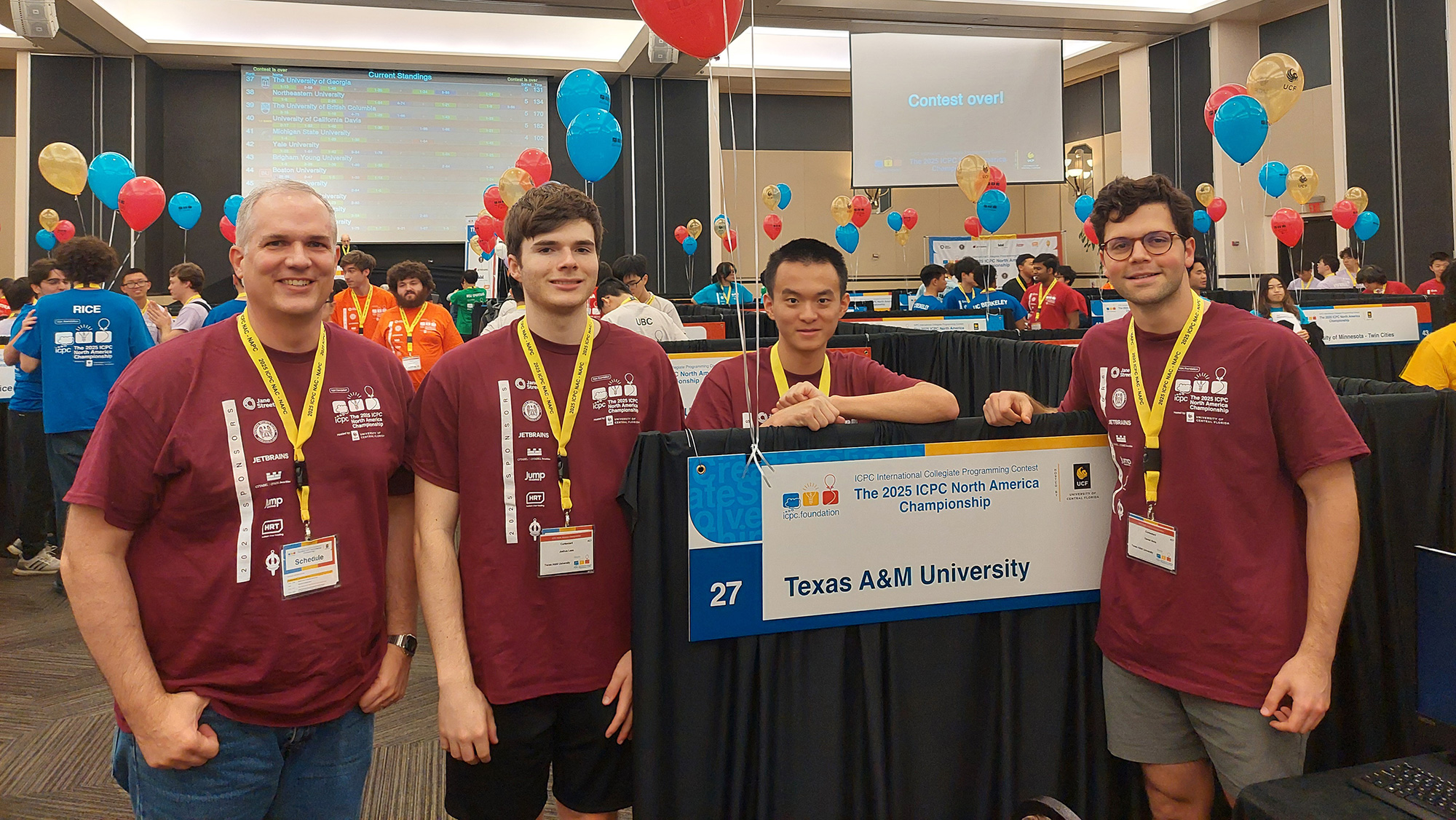
Joshua Lass ’26, Andrew Li ’26 and Daniel Mota ’25 represented Texas A&M University in the world’s largest collegiate algorithmic programming competition.
Together, the team traveled to Baku, Azerbaijan — the city of winds — for the International Collegiate Programming Contest (ICPC) World Finals. This year, the competition was hosted by Azerbaijan’s ADA University and ran from Aug. 31 through Sept. 5. The top 140 teams qualified for the world finals out of the 73,083 students from 3,424 universities in 103 countries that participated in ICPC events this season.
Lass, Li and Mota placed among the top 10 teams from the United States and 51st overall at the world finals. This is the third time in over 25 years that a team from Texas A&M has qualified for the world finals and the highest any have placed.
“I was extremely happy with their performance,” said Dr. John Keyser, the team’s coach and professor of computer science and engineering.
The team competed under the name hyper. Lass, a senior computer science and applied math double major, explained that the name comes from “hypergrind,” the way the team describes training for the contest.
“Three years of hard work got us here,” said Lass, ahead of the competition. “I’ve probably averaged three hours of work per day for the last three years.”
The team advanced after qualifying at the ICPC North America Championship in May, facing the 51 best teams from universities in the United States and Canada.
“[The team] put a lot of work into this, especially through the spring, when they were practicing many hours every week leading up to nationals,” Keyser said. “It was really nice to see a payoff after all the work they’ve done.”
[The team] put a lot of work into this, especially through the spring, when they were practicing many hours every week leading up to nationals. It was really nice to see a payoff after all the work they’ve done.
ICPC is a five-hour contest where teams of three race to solve real-world programming problems.
“I really enjoy this contest,” Lass said. “Solving the problems is fun. I don’t feel like I’m working.”
To reach the world finals, the team competed in three prior rounds. First, they completed a qualifying round against the other programming teams from Texas A&M. Next, they faced teams in the South Central North America Region, before ultimately competing in the North America Championship. With each round, the programming problems increased in difficulty.
In addition to time pressure, teams face the logistical challenge of sharing one computer. This is an area where team hyper excels.
“I think [sharing a computer] is actually one of the things we excel the most at because of how well we know each other and the amount of time we’ve spent competing,” said Mota, a computer engineering major. “We know when someone should be thinking, when someone should be drawing out diagrams, and when someone should be coding. Computer time is super, super valuable.”
Lass, Li and Mota have been teammates for three years. Lass described them as a team of specialists. He specializes in tree problems and used an example to explain what those are.
“You could have a bunch of unconnected cities, and you want to build roads between them so that every city could visit another city by road,” Lass said. “A computer science problem could be minimizing the number of roads, and the roads you build form a tree.”
Mota specializes in dynamic programming problems, but he described another way he contributes to the team during the competition.
“I played a lot of sports growing up, and I’ve done lots of non-coding related contests. So, I felt like I had a big edge,” said Mota. “I think that played a big role in settling my nerves on the big stage. We were stuck during the first two hours [of the North America Championship], but I focused, solved the problem by myself, and I kind of gave the team a second wind.”
The team members had internships over the summer but stayed in contact with each other and Keyser to prepare for the world finals. In the final weeks before the contest, they planned to go through five-hour practice sessions to prepare for the five-hour competition.
Mota reflected on Dr. Keyser’s impact on the team and commitment to the contest.
“I think it’s pretty hard to quantify how much Dr. Keyser’s work and effort has changed our lives, and not only our lives but the other [Texas A&M] teams who didn’t make it and people who take his class,” said Mota. “Most of the internships we landed are in a large part due to having the contest on our resume. I think Dr. Keyser does a great job, and he really cares about this, so big thanks to him.”